 |
||
|
||
| ||
"A whole team and a dog under the wagon"
A saying It's been a long time since the first TV tuner supporting hardware MPEG-1/2 compression appeared. But AVIOSYS International Inc., Adaptec, Inc., YUAN High-Tech Development Co. products were mainly positioned as capture boards with tuners and not vice versa, which reduced the number of potential purchasers. The use of hardware MPEG-1/2 compression was an unexpected success in tuners with a USB2.0 interface, and it was largely due to the absence of rival solutions with program coding at that momet. However, as time went by the situation changed. Transcend USB2.0 TV-Box is a perfect illustration of the fact that one can be competitive in this sector too. But that's not the point, actually. Our readers know Prolink Microsystems Corporation as a manufacturer of PixelView videocards, although the company also produces a wide range of items, such as TV tuners (including ones with a hardware MPEG-1/2 support). PixelView PlayTV@P7000, the company's new product, is unique in a way. It is a tuner with hardware MPEG-1/2 compression that is positioned not as a professional capture board but rather as a solution for a home media PC. Let's try to evaluate the result of this approach. Complete package
The designers of the box have done their job well. Besides, a titanic remote controller clearly implies a central role of PlayTV@P7000 among other multimedia components.
 The package includes:
Our tuner was designed for testing, and the package included no mini-jack — 2 RCA sound cable and no full version of the guide (although it was on the CD in the pdf format). Besides the programs made for work with the tuner, the CD also contained InterVideo's WinDVD 5 player (version 5 is a recent one). Construction and specsThis is what we've got this time:
Timeshifting, Multi Channel Preview and a Recording Manager are certainly present in the model.
Of course, the company couldn't but use some unique technologies, such as eDrive (tuner control via e-mail) and C.P.U-Cellular Phone United (control via e-mail sent from a cell phone).
Signal reception is ensured by a Philips FQ1216ME/I H-3 HF unit.
We already met it in ComproVideoMate
Live USB2.0, MaxSelect
DVD2Go MPB680 and ATI's All-In-Wonder
video combines. 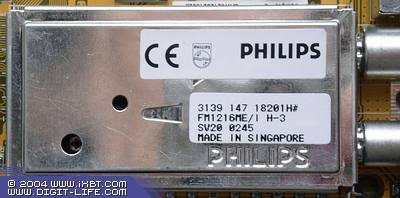
Analog/digital convertion is done by a 10-bit Conexant CX23882-19.
 A Conexant CX23416-12 chip placed under the heatsink executes hardware support of MPEG-1/2.
M.Tec. 8 MB 5.5ns memory is used as the buffer of the MPEG coder.
 As we see, PlayTV@P7000 only differs from MaxSelect DVD2Go MPB680 in the ADC and the data transmission interface. Now let's see how it works in reality. Test computer configuration
ConnectionA low-profile board along with no need of sound transmission connector reduced a customary full set of connectors. Composite video signal is transmitted via an adapter and the MiniDIN 7-pin connector which is also used for S-Video.
 Antenna connectors are deepened into the case, and for some reason, the package only has one adapter. However, it is easy to buy as many as you like, and besides, an antenna connector can be enough even without one. Noteworthy, it is the first tuner that realises sound transmission via PCI (CX2388x supports it). And there's no alternative to it in the form of any inner or outer connector. Installation and tuning
The installation menu is quite sensible.
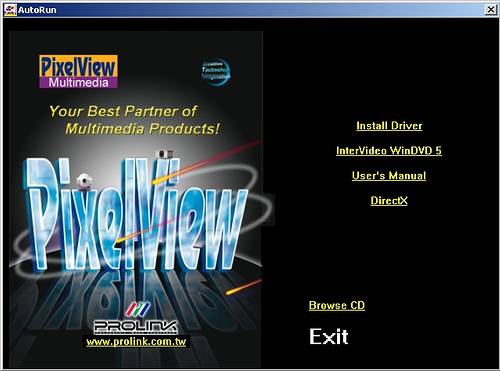 During installation, you're informed about the need of Windows Media Player 9, and older versions are renewed automatically.
These are the devices we get when the installation is completed:  Operations with the tuner are ensured by Genesis Digital Innovations software that refuses to work more than 30 days unless you make an on-line registration. Which makes me wonder about customers who have no Internet access: what are they supposed to do?
This is the Tuning Wizard that appears when you first start the PV Center TV program. 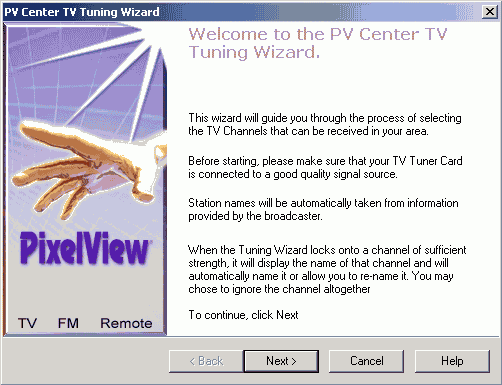
Absence of Russia is really puzzling.
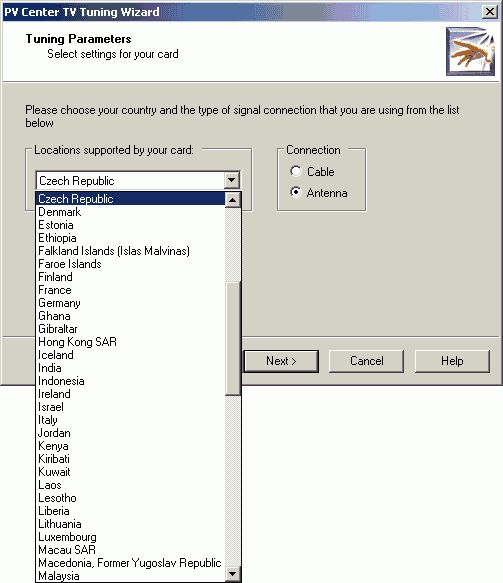
The program allows to skip unfavourite channels or "air garbage".
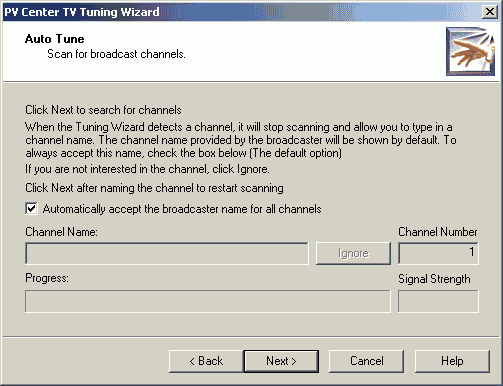 The selection of the Czech Republic gives the closest result, although some Russian channels still can't be found.
The situation is mended by the Use DX9 Tuning Tables check-box that appears along with Slow frequency scan at the second scanning.
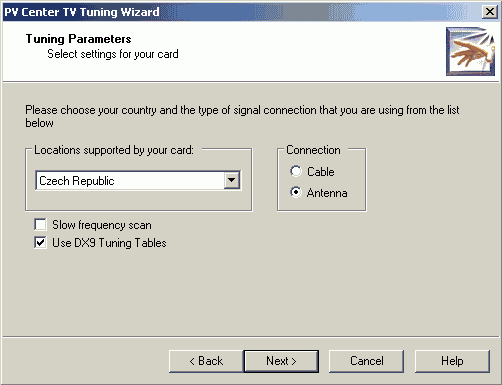
The resulting list does not completely coincide with our broadcasting network, but still, I found all the channels I wanted. On the other hand, it's not improbable that some channels will remain unfound in other conditions.
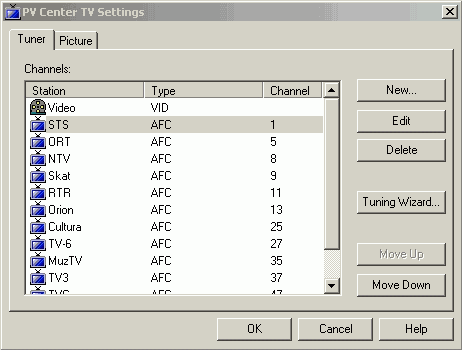
However, the list can be edited and there are different ways to add new channels including a direct frequency entering (that not always works correctly).
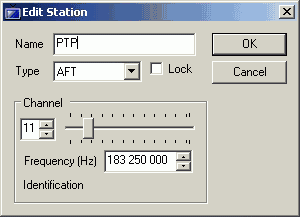
Picture settings can also be found here.
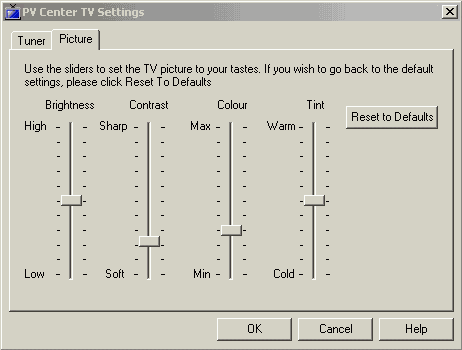 Colour systems can't be chosen, so when you start PV Center TV you have to switch the channel at least once to make the colour appear. Ironically, this approach turned out to be convenient for those who have channels in different colour systems. For example, to switch to a channel in PAL, you only have to switch a channel in SECAM to the Video-In and then to the channel in PAL. Reverse switching is done in a normal way. Of course, such variant can't be called very convenient, but in many cases, this succession is at least not worse than the choice of the colour standard for all the channels, as is realised by most manufacturers. But the question is whether Prolink Microsystems Corporation experts knew about such possibility :-) . The PV Center TV look gives an answer to the question about the necessity of WMP 9: the program uses its standard interface, only the colour spectrum is different.

The Features section of General settings deals with operation modes and, in fact, duplicates the panel buttons.
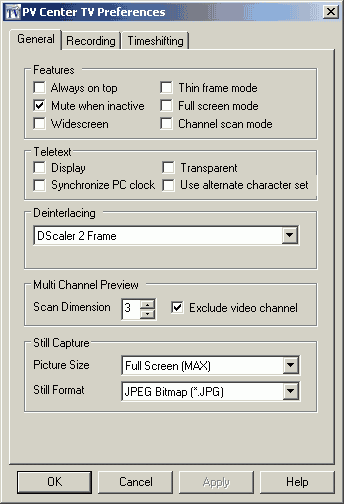
The tab also includes the settings of the teletext, the Multi Channel Preview mode, frame capture, and multi-filter deinterlacing.
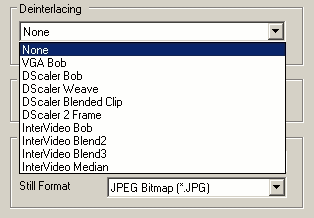 As for Recording settings, they stand no comparison with, say, MaxSelect
DVD2Go MPB680. 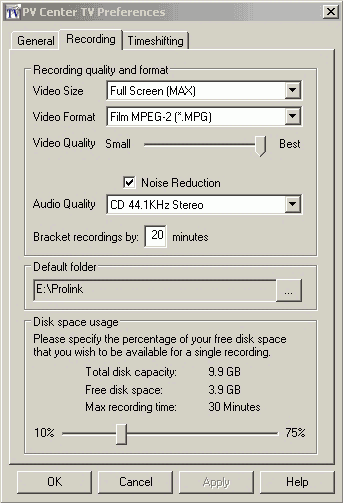
The bitrate is regulated by an abstract Video Quality slider, resolution is selected almost at random (I daresay, not every user can tell the difference between CIF and QCIF, and the guide gets away with the following diplomatic phrase: "Larger sizes will give better quality when viewed full screen in your playback application but require more disk space and processor power"). Besides, any resolution changes are useless as the file will have 768x576 anyway (no misprints, it's really 768, not the announced 720). Good job the bitrate can be regulated at all.
 Timeshifting settings are similar to the Recording ones, to the extent that a separate enabling/disabling of Noise Reduction is impossible, and the change occurs simultaneously. 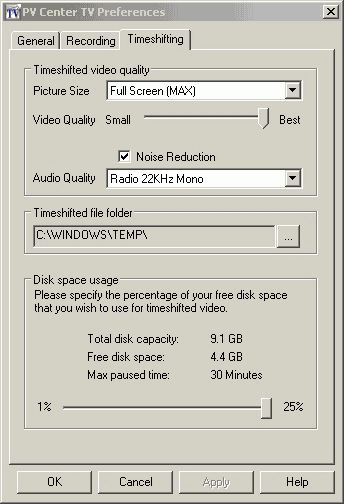
This mystic connection doesn't enable recording with Timeshifting disabled: the program generates a mistake and refuses to record. The user guide promises to eliminate the mistake in future versions.
 It would certainly pass as a trifle but with Timeshifting enabled, three of my channels (1, 3, 7) displayed a slide show instead of a normal picture. Moreover, the CPU load reaches a 100 percent. A true poltergeist, is it not? Speaking about the load, recording at maximal settings takes up to 35 percent of the CPU resources, which is a bit strange for a hardware coder.
Before saving the recorded file to the HDD, you can view the result and add it to the Windows Media Player playlist.
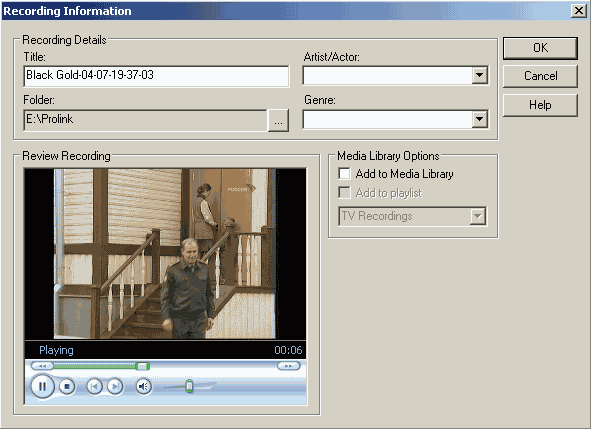
Quality
It must be said that the CX23882-19 + CX23416-12 liaison revealed its full potential here. The combination of a 10-bit ADC and a hardware coder with an effective noise reduction system was a pleasant surprise. Besides, PlayTV@P7000 was the first tuner to ensure a good quality of two of my channels that had a weak signal. So, feel the difference: the frames on the right were made with ECS
EZ-TV, one of the most quality tuners in my conditions. Unfortunately, we found some drawbacks here too: a strip on the right, typical of CX2388x, is more evident in this tuner than it was in the ones we tested before. As for the sound quality, it is quite up to the mark. Additional capabilities
We have already said enough about Timeshifting. As for the Multi Channel Preview function, it supports a record maximal number of cells: from 2x2 to 15x15.

The recording manager is convenient but it doesn't support switching off or shifting to the standby mode after the recording is finished.
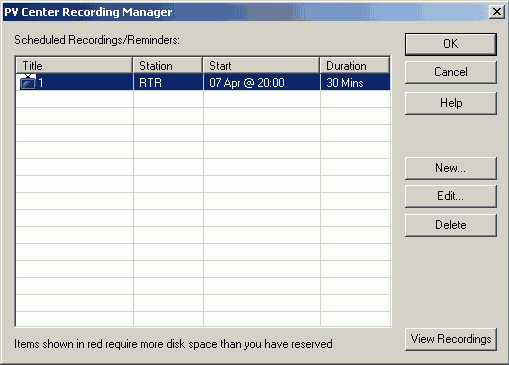 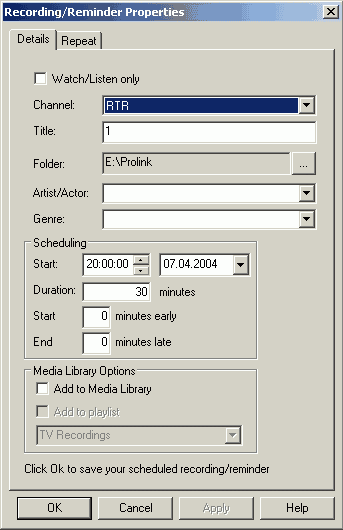 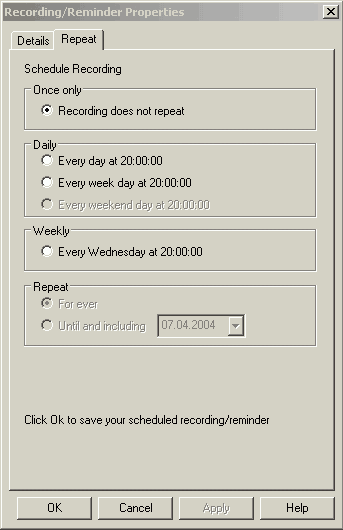 The image gallery is absent, and the Snapshot button invokes a file save window right away. That's when you remember the unsuccessful attempts to change the resolution as all the captured frames are 384x288 irrespective of the settings. We can only hope that all resolution problems will be solved in future versions of drivers and software. Don't think we have forgotten about the eDrive technology, we'll come back to it a bit later. FM tuner
The PV Center FM Radio program organises the search for FM stations in a similar way as its TV counterpart does.
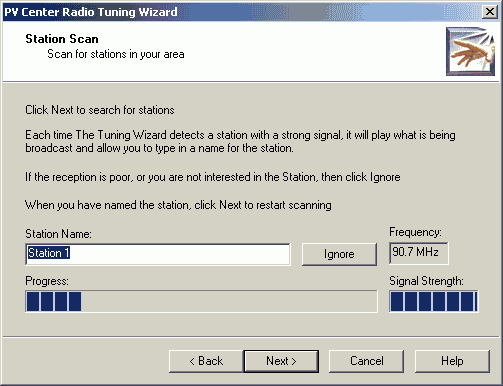
Despite the absence of any sensibility settings, the search didn't find too much although provided us with all working stations. 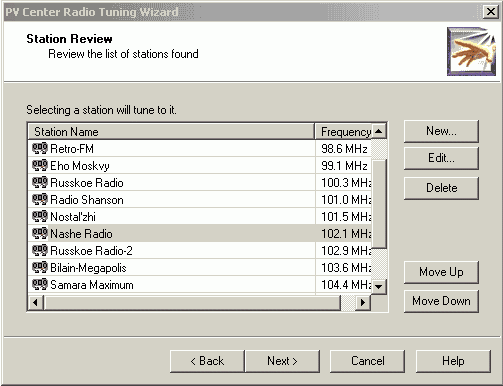
So we didn't have to enter the stations manually.

The program's interface is extremely minimalistic although there are no claims about its convenience.
 The sound decoded by CX23882 has a quite good detalisation (I hope Hi-Fi fans will forgive my saying this :-) ) . Unfortunately, recording is only possible in wma at 96 Kbit/sec. So we had to record the test files right from the sound card. Well, it's a pity; with a quality like this, developers might at least have left us the wav format. Frankly, I couldn't choose the best fragment, so here they all are (470KB, 20 sec., mp3, 192 Kbit/sec, 48KHz): I was surprised to know that PV Center FM Radio can work with a TV antenna, so you can do without an FM one if you have air television. And of course, it has a very positive impact on the reception quality. Pity that cable subscribers can have no such opportunity. Remote controller
But in contrast to Remote Wonder, this RC uses the IR spectrum and the general approach to the remote control is different. The RC does not depend on any program, and its standard settings cater to most users. But that's not all. Choose any button 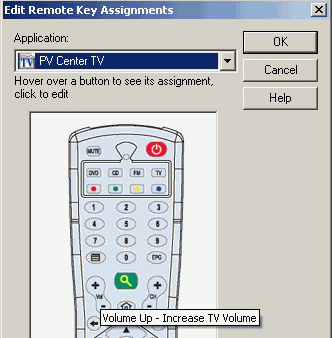
and you can change its function to any of multiple standard ones.
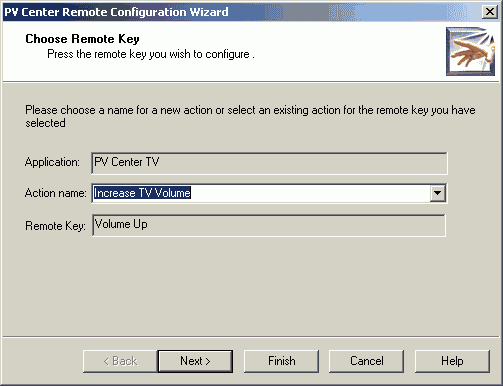
But if you don't stop at that, you'll be impressed with the opportunities that appear. For example, in contrast to Remote Wonder, it allows function execution while a button is held down or only in the active application.
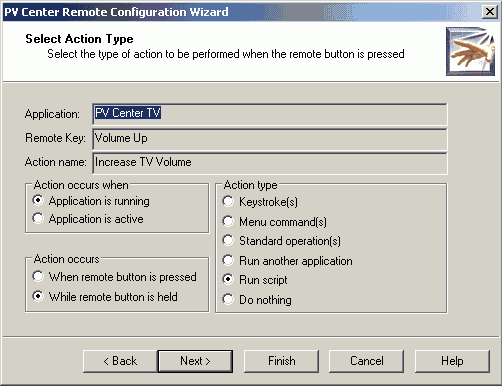
Moreover, the RC can use Visual Basic scripts, opening wide horizons for creativity.
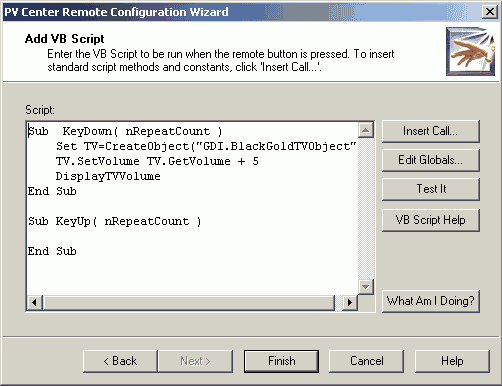
And finally, it has its own graphic interface.

The eDrive technologyVisual Basic enables an elegant organisation of e-mail handling.
The function is activated in the PV Center Remote Controller icon.
The setting process is very simple. We enter the e-mail address,
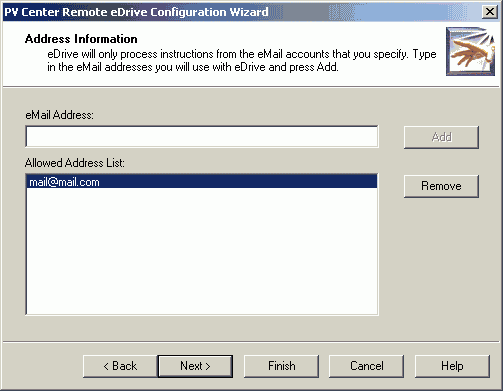
type the subject of the letter for PV Center Remote Controller to identify it,
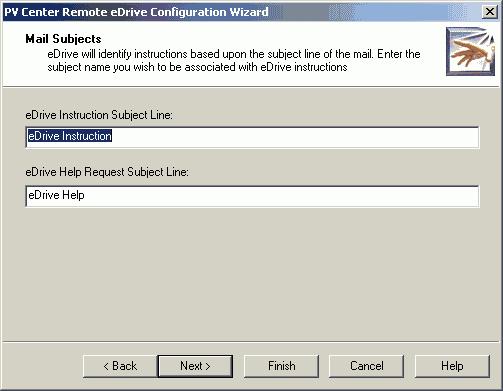
and then specify the frequency of connection and run the mail client.
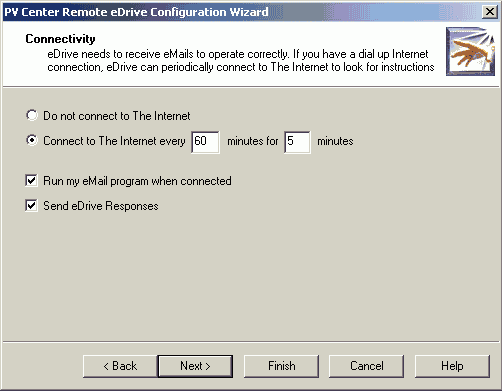 Now the program will process all Visual Basic scripts contained in the sent letters with a corresponding subject. Well, the developers proved to be really creative and original in this respect. Conclusions
Merits
Demerits
No doubt, it is an ambiguous but very interesting product: a quality picture, an excellent sound and an innovative RC against a number of interface problems. But basic shortcomings can easily be corrected, and should this happen, PixelView PlayTV@P7000 has every chance to become a desirable product for those who needs a quality tuner with a hardware MPEG-1/2 support.
Current average price (supply quantity) for PixelView PlayTV@P7000 in Moscow retail stores:
[an error occurred while processing this directive]
|
Platform · Video · Multimedia · Mobile · Other || About us & Privacy policy · Twitter · Facebook Copyright © Byrds Research & Publishing, Ltd., 1997–2011. All rights reserved. |